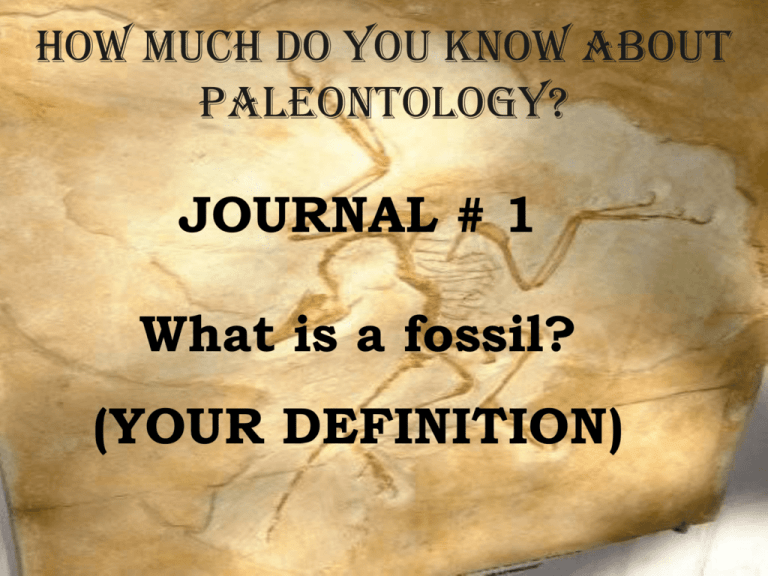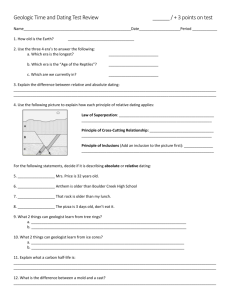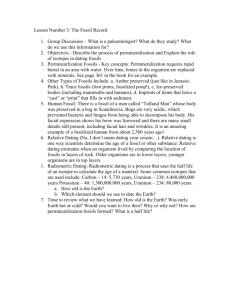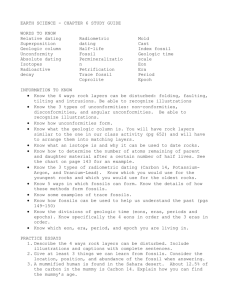Document 9241892
advertisement

How much do you know about Paleontology? JOURNAL # 1 What is a fossil? (YOUR DEFINITION) How much do you know about Paleontology? Pre-Unit Questions Answer the following True/False Questions We can use carbon dating to identify the age of a dinosaur fossil. 50% 50% 1. True 2. False How much do you know about Paleontology? FALSE. Although carbon dating is used to date formerly living organisms, dinosaurs are considered far too old to date using carbon-14’s shorter half-life. Many scientists theorize that dinosaurs were wiped out many years ago by some great catastrophe. 0% 1. True 0% 2. False How much do you know about Paleontology? TRUE. Obviously dinosaurs don’t exist today and they seem to disappear suddenly from the fossil record. Fossils take millions of years to form. 0% 0% 1. True 2. False How much do you know about Paleontology? TRUE or FALSE? FALSE. Fossils can form in less than a year depending on the conditions. Through radiometric dating, we can identify the age of A dinosaur fossil. 0% 0% 1. True 2. False How much do you know about Paleontology? FALSE. At least NOT DIRECTLY Radiometric dating (except carbon dating) is mostly performed on igneous rocks. Fossils form in sedimentary rock. There are billions of fossils found all over the earth. 0% 0% 1. True 2. False How much do you know about Paleontology? TRUE. There are many fossils buried in the rock all over the planet. Over 99% of them are small marine plants and animals. Dinosaurs are “giant lizarDs.” 0% 0% 1. True 2. False How much do you know about Paleontology? FALSE. Some were large, but many were not. The term dinosaur, coined in the 1800’s, does mean “terrible lizard,” but the average size of a dinosaur was that of a large dog. Geology: Paleontology & Geologic Time Created in 2008 by Tim F. Rowbotham Geology is the study of the origin, history, and structure of the earth. Paleontology is the study of prehistoric life, particularly through fossil remains. Fossils are the remains, imprints, or traces of prehistoric organisms. Fossil Formation Requires shelter from scavengers, decay, and physical destruction. Fossil Formation • Most commonly occurs through quick burial by sediment. • Is more likely to occur with hard parts such as bone, shells, and teeth. Types of Fossils Types of Fossils • Permineralized remains • Carbon films • Molds & Casts • Original Remains • Trace Fossils Permineralized Remains occur when parts of the original remains are replaced by minerals flowing through ground water. This process is called petrification. Permineralized Remains Fossil turtle shell Permineralized Remains Fossil dimetrodon Permineralized Remains Petrified wood Permineralized Remains Baby protoceratops Permineralized Remains Whale fossil Permineralized Remains Fossil tyrannosaurus Carbon Films occur when pressure from layers of sediment leaves only a thin carbon residue. Carbon Films Beech leaf Carbon Films Ancient salamander Carbon Films Fossil fish Molds & Casts Formation of fossil shell molds Molds are hollow areas left in sediment that show the shape of the original organism. Molds & Casts External mold of shell Molds & Casts Internal mold of shell Casts are copies of the shape of original organism that form from minerals deposited into the mold. Molds & Casts Cast of trilobite Molds & Casts Formation of fossil shell molds Original Remains including the soft parts of the organism are sometimes found in hardened tree resin, frozen ground, or tar pits. Original Remains Bee encased in amber Original Remains Scorpion in amber Original Remains Mammoth hair Trace Fossils provide evidence of an organism’s activity. They include footprints, trails, burrows, and excrement. Trace Fossils Dinosaur tracks Trace Fossils Fossil trails of climactichnites Trace Fossils Fossil burrows How much do you know about Paleontology? Review Questions Which type of fossil is shown to the right? 0% 0% 0% 0% 1. 2. 3. 4. Cast Mold Carbon Film Permineralized remains Which type of fossil is shown to the right? 0% 0% 0% 0% 1. 2. 3. 4. Permineralized remains Cast Mold Carbon Film Which type of fossil is shown to the right? 0% 0% 0% 0% 1. 2. 3. 4. Original remains Cast Mold Trace Fossil Which type of fossil is shown to the right? 0% 0% 0% 0% 1. 2. 3. 4. Cast Mold Carbon Film Trace Fossil Fossil Activity and Timeline You will work in groups of 3 or 4 (tables) to complete the activity as described on the following slides. Fossil Activity: Part 1 • We will travel to each station and record the name of each fossil and a sketch or brief description (you will have 1-2 minutes at each station so don’t waste any time). Once you have traveled to all of the stations you will return to your original table and put the fossils in order from oldest to most recent. (Remember this is just a “guess” you and your group should agree on the order). Fossil Activity: Part 2 • You should be back at your table and ready to start researching your fossil. Please research and answer the following questions concerning your fossil. 1. What time period in geologic history did your organism live in and how long did that period last? Example: Eocene time period from 34 to 65 MYA 2. When did the organism first appear on Earth? 3. Is the organism extinct or does it still exist today? If it is extinct what are its closest living relatives? 4. What environment did the organism inhabit? 5. What other organisms lived during this time period (at least 4). Fossil Activity: Part 3 • Create a brief presentation of your organism including the important information you collected during your research (all but #5). Be prepared to present the information to the class. Archaeopteryx Triceratops Trilobite Ammonite Flowering tree Protozoa Green Algae Shark Fossil Activity: Part 3 • Once all of the groups have completed presenting go back and fix any of the mistakes you may have made in ordering the organisms. • Describe any patterns you see in the list (fossil record). How do the organisms change throughout history? Where do you think animals such as birds would go on your list? Justify your answer! Fossils Reading Passage GET YOUR REMOTES WHEN YOUR GROUP FINISHES THE HANDOUT READY YOUR REMOTES Which type of fossil is shown to the right? 0% 0% 0% 0% 1. 2. 3. 4. Original remains Cast Mold Trace Fossil Which type of fossil is shown to the right? 0% 0% 0% 0% 1. 2. 3. 4. Original remains Cast Mold Trace Fossil Which type of fossil is shown to the right? 0% 0% 0% 0% 1. 2. 3. 4. Original remains Cast Mold Trace Fossil Which type of fossil is shown to the right? 0% 0% 0% 0% 1. 2. 3. 4. Original remains Cast Mold Carbon Film Which type of fossil is shown to the right? 0% 1. 0% 2. 0% 3. 0% 4. Permineralized remains Cast Mold Carbon Film Dinosaur National Monument Paleontology Notes Day 2 Relative Age is the “age” of a rock or strata compared to the ages of other rocks or strata. Relative Age Principle of Superposition as sedimentary rocks form, they are deposited on older rock layers. Principle of Superposition in undisturbed layers, the oldest is on the bottom and higher layers are younger. Principle of Superposition Oldest layer is on bottom (1) Principle of Superposition The Grand Canyon Principle of Superposition The Grand Canyon Uniformitarianism is the idea that the processes occurring on earth today are similar to those that occurred in the past. Uniformitarianism basically says “The present is the key to the past.” Uniformitarianism is the idea that geological features formed slowly over long periods of time. Uniformitarianism claims the Earth is 4.6 billion years old. What does the Principle of Superposition say? 0% 0% 0% 0% 1. 2. 3. 4. Sedimentary rocks form in rivers Igneous rocks form faster than sedimentary New rock layers form on top of older ones There are billions of fossils on Earth Which layer of rock is the oldest? 0% 0% 0% 0% 0% 1. 2. 3. 4. 5. 1 2 3 4 They are all the same age HOW OLD WOULD MOST GEOLOGISTS SAY THE EARTH IS? 0% 0% 0% 0% 1. 2. 3. 4. 6000 years 75,000 years 20 million years 4.6 billion years According to what theory, is the earth 4.6 billion years old? 0% 0% 0% 0% 1. 2. 3. 4. Catastrophism Uniformitarianism Geologism Agism Flashback Principles of Geology Paleontology Notes PAGE 4-5 Extrusions are igneous rocks layers that form on the surface when lava hardens. Extrusions are always younger than the layers over which they form. Extrusion Kubu Rock – Botswana, Africa Intrusions are igneous rocks that form when magma pushes up into rock layers. Intrusions are always younger than the rock layers they invade. Intrusion Devil’s Tower, WY Intrusion Devil’s Tower, WY In the image below identify as many intrusions and extrusions as you can! Stop and Summarize Journal #3 - 1 Draw the following geologic cross-section: 1.) 2 layers of sedimentary rock form. 2.) An extrusion forms on top of the two layers. 3.) A 3rd layer of sedimentary rock forms. 4.) An intrusion cuts through the all the rock layers, but not to the surface. 5.) A 4th layer of sedimentary rock forms. Faults are breaks in the earth’s crust. A fault is always younger than the rock it cuts through. Faults Faults Shoshone Fault, CA Folds occur when rock layers are compressed together and bend or curve. Folds Guadalajara, Spain Folds Mojave Desert, CA Stop and Summarize Journal #3 - 2 Draw the following geologic cross-section: 1.) 2 layers of sedimentary rock form and a fold occurs causing the layers to bend and curve 3.) A 3rd sedimentary layer forms. 4.) A fault cuts through all the layers 5.) A 4th sedimentary layer forms. 6.) An intrusion cuts all the way to the surface forming an extrusion. Unconformities are gaps in the rock sequence (caused by the erosion of rock layers). Angular Unconformity occur when rock layers are tilted or uplifted, and then worn down by erosion and weathering. Sediments are then deposited on top of these eroded layers. Angular Unconformity Angular Unconformity Angular Unconformity Disconformities are gaps created when erosion occurs on an overlying rock layer. Disconformity Disconformity Disconformity Nonconformity are formed when sedimentary rock overlays igneous or metamorphic rocks. Nonconformity Nonconformity Nonconformity Egypt Unconformities Stop and Summarize SOME Relative Dating Practice Write the correct order of events by numbering their occurrences. Include any and all cross-cut relationships. Relative Dating Example Relative Dating Relative Dating Relative Dating Correlation is using rock and fossil evidence to match up dating at different locations. Correlation Index Fossils are used for dating the rock layers in which they are found. Index Fossils are species that were abundant all over the earth, but existed for shorter periods of time. Index Fossil trilobite Index Fossil ammonite Index Fossil Correlation using index fossils Index Fossil Correlation using index fossils What kind of crosscut is shown to the right? 0% 0% 0% 0% 1. 2. 3. 4. Intrusion Extrusion Folds Unconformity What kind of cross-cut is shown to the right? 0% 1. Intrusion 0% 2. Fault 0% 3. Fold 0% 4. Angular Unconformity What kind of cross-cut is shown to the right? 0% 1. Intrusion 0% 2. Fault 3. Fold 0% 4. Angular Unconformity 0% What is the name of the type of fossil is used to correlate rock layers at two or more different locations? 0% 1. Mold 2. Petrified fossil 0% 3. Index fossil 0% 4. Trace fossil 0% Using correlation, Which two layers would you determine to be of the same age? 0% 0% 0% 0% 1. 2. 3. 4. A&D A&B B&D B&E Paleontology Notes RETURN YOUR REMOTE Finding Clues to Rock Layers HW: (Pal Pack) p.18 “The Grandest Canyon of All” p.19 “Relative Order of Geologic Events” p. 20 “Geologic Puzzles” Paleontology Notes READY YOUR REMOTE FOR A QUICK REVIEW What type of cross-cut appears at location e? 0% 0% 0% 0% 1. 2. 3. 4. Fault Fold Nonconformity Angular Unconformity What type of crosscut appears in the picture? 0% 0% 0% 0% 1. 2. 3. 4. Fault Disconformity Nonconformity Angular Unconformity Absolute Age is the age in years of a rock or other object (as determined by radiometric dating. Radiometric Dating entails finding the amount of certain radioactive elements left in a rock or object. Radioactive Dating Game INSTRUCTIONS RETURN YOUR REMOTE PICK UP Radioactive Dating Game WS TURN IN Finding Clues to Rock Layers Journal TURN TO YOUR JOURNAL PAGE Journal #5 Draw a geologic cross-section with the following: 1.) At least 5 sedimentary rock layers 2.) At least 3 cross-cuts (faults, folds, intrusions, extrusions, or unconformities) Write a geologic history that explains the order of occurrence of each event. Paleontology Notes READY YOUR REMOTE FOR A QUICK REVIEW Which of the following is oldest? 0% 1. 0% 2. 0% 3. 0% 4. Sandstone B Sandstone A Earthquake fault Igneous Dike B What type of cross-cut appears at location e? 1. Fault 0% 2. Fold 0% 3. Nonconformity 0% 4. Angular Unconformity 0% What type of crosscut appears in the picture? 1. Fault 0% 0% 2. Disconformity 0% 3. Nonconformity 0% 4. Angular Unconformity Paleontology TURN TO PAGE 9 OF YOUR NOTES Absolute Age is the age in years of a rock or other object (as determined by radiometric dating. Radiometric Dating entails finding the amount of certain radioactive elements left in a rock or object. Radioactive Decay is the release of particles and energy from the nuclei of unstable atoms. Radioactive Elements are elements whose nuclei are unable to hold together, and eject particles and energy. The Parent Element is the element whose nucleus radioactively decays into another element. The Daughter Element is the new element that is produced after the decay of the parent element. Half-Life is the time it takes for half of the atoms in a sample to decay. Half-Life is always the same. It does not depend on the amount of atoms. Half-Life is unaffected by almost all other outside factors. Decay occurs at a steady rate. Sample Half-lives ISOTOPE HALF-LIFE PARENT DAUGHTER URANIUM 238 LEAD 206 4.5 BILLION YEARS POTASSIUM 40 ARGON 40 1.3 BILLION YEARS THORIUM 232 LEAD 208 14.0 BILLION YEARS CARBON 14 NITROGEN 14 5,730 YEARS Sample Half-lives Iodine-129 16,000,000 years Carbon-14 5730 years Strontium-90 28 years Sodium-24 15 hours Technetium-99 6 hours Fluorine-18 110 minutes Oxygen-15 124 seconds Radiometric Dating As time passes, the amount of a parent isotope in a rock decreases as it decays. It has decayed into the daughter element. Radiometric Dating basically involves measuring how much of the daughter element has formed. Age Determination can then be made by using the known half-life to determine how much time has passed. Age Determination typically, the dating can be estimated only up to a MAX of 10 half-lives. Common Types of Radiometric Dating Potassium-argon dating Uranium-lead dating Rubidium-strontium dating Radiocarbon dating Potassium- Argon Dating Potassium-40 decays to Argon-40. Potassium-40 has a half-life of 1,300,000,000 years. (used on igneous & metamorphic rock) Uranium-Lead Dating Uranium-235 decays to Lead-207 Half-life: 700,000,000 years Uranium-238 decays to Lead-206 Half-life: 4,500,000,000 years (used on igneous & metamorphic rock) Rubidium-Strontium Dating Rubidium-87 decays to Strontium-87 Rubidium has a half-life of 50,000,000,000 years. (used on igneous & metamorphic rock) Radiocarbon Dating Carbon-14 decays to Nitrogen-14. Carbon dating is used to measure how long an organism has been dead. USED ON FORMERLY LIVING ORGANISMS Paleontology Notes 1.) Return your Remote 2.) Complete “Radioactive Dating” WS 3.) Complete PACKET Radioactive Dating WS Radioactive Dating Game INSTRUCTIONS Paleontology Notes Turn to page 12 Radiocarbon Dating Carbon-14 decays to Nitrogen-14. Carbon dating is used to measure how long an organism has been dead. USED ON FORMERLY LIVING ORGANISMS Radiocarbon Dating Since nitrogen is a gas, no daughter element is left to measure. Carbon dating is done by comparing how much radioactive carbon (C-14) is left in the organism compared to stable carbon (C-12) How Carbon-14 Is Produced Cosmic Rays (radiation) Forms C-14 Collision with atmosphere (N-14) C-14 combines with oxygen to form carbon dioxide (CO2) www.icr.org When Does the Clock Start? Once a plant or animal dies the clock starts Organism dies C-14 continues to decay No more C-14 intake www.icr.org Radiocarbon Dating The present ratio is 100 C-14 atom per 100 trillion C-12 atoms. (Scientists must assume that this was also the ratio when the organism died) After the organism dies, C-14 decays, but the C-12 is left unchanged. Determining the Starting Amount • There are two types of carbon used in the dating process: C-12 and C-14 • C-12 is a stable isotope (it does not decay) • When an organism is alive it has the same ratio (C-12 to C-14) that is found in the atmosphere (1-trillion to 1) I’m alive I’m a fossil Same ratio www.icr.org Different ratio Radiocarbon Dating C-14 No measurable C-14 C-14 C-12 C-12 C-12 Amount constant Amount constant Amount constant Moment of death OLD TOO OLD TO DATE Radiocarbon Dating After 1 half-life (5,730 years) there are only 50 C-14 atoms per 100 trillion C-12 atoms. After 2 half-lives (11,460 years) there are only 25 C-14 atoms, etc. This ratio can then be measured to determine the age of the dead organism. How the C-12 / C-14 Ratio Works Amount of stable C-12 Amount of unstable C-14 Ratio 100 Trillion 100 1-T to 1 0 0 100 Trillion 50 2-T to 1 5,730 1 100 Trillion 25 4-T to 1 11,460 2 100 Trillion 12.5 8-T to 1 17,190 3 100 Trillion 6 16-T to 1 22,920 4 100 Trillion 3 32-T to 1 28,650 5 Years Dead # Half-lives “The important thing is to never stop questioning.” - Albert Einstein Radiometric Dating Assumptions – What do we need to determine age? 1) 2) 3) 4) Current amount of parent Decay Rate (Half-Life) Starting amount of parent None of the parent or daughter has been gained or lost (contamination or leeching) Radiometric Dating Assumptions – What we DO know? 1) Current amount of parent/daughter YES, this can be measured, though it can be a very tiny amount 2) Decay rate YES, we are fairly confident that the half-life is constant. 3) Starting amount of parent/daughter NO, we MUST MAKE AN ASSUMPTION!?!? 4) None of the parent or daughter has been gained or lost NOT SURE, Geologists try to pick samples that do not show signs of leeching or contamination. What is the only type of radiometric dating that can be used on formerly living organisms? 0% 0% 0% 0% 1. 2. 3. 4. Uranium-lead dating Potassium-argon dating Rubidium-strontium dating Carbon Dating What is the oldest fossil carbon dating can be accurately used to measure? 0% 0% 0% 0% 1. 2. 3. 4. 5,730 years 57,300 years 200 million years 4.5 billion years Paleontology Notes 1.) Complete “Radioactive Dating” WS 2.) Return your Remote 3.) Complete The Radioactive Dating Game Activity WS Paleontology Notes 1.) Return your Remote 2.) Complete “Radiometric Dating Practice” 3.) Complete “Clues to the Earth’s Past” Paleontology TEST WEDNESDAY How much do you know about Paleontology? Pre-Unit Questions (Post-Unit) Answer the following True/False Questions How much do you know about Paleontology? Pre-Unit Questions (Post-Unit) Answer the following True/False Questions We can use carbon dating to identify the age of a dinosaur fossil. 0% 0% 1. True 2. False How much do you know about Paleontology? FALSE. Although carbon dating is used to date formerly living organisms, dinosaurs are considered far too old to date using carbon-14’s shorter half-life. Many scientists theorize that dinosaurs were wiped out many years ago by some great catastrophe. 0% 0% 1. True 2. False How much do you know about Paleontology? TRUE. Obviously dinosaurs don’t exist today and they seem to disappear suddenly from the fossil record. Fossils take millions of years to form. 0% 0% 1. True 2. False How much do you know about Paleontology? TRUE or FALSE? FALSE. Fossils can form in less than a year depending on the conditions. Through radiometric dating, we can identify the age of dinosaur fossils. 0% 0% 1. True 2. False How much do you know about Paleontology? FALSE. Radiometric dating (except carbon dating) is mostly performed on igneous rocks. Fossils form in sedimentary rock. HOWEVER, estimates are made based on radiometric dating of igneous intrusions & extrusions There are billions of fossils found all over the earth. 0% 0% 1. True 2. False How much do you know about Paleontology? TRUE. There are many fossils buried in the rock all over the planet. Over 99% of them are small marine plants and animals. Dinosaurs are “giant lizarDs.” 0% 0% 1. True 2. False How much do you know about Paleontology? FALSE. Some were large, but many were not. The term dinosaur, coined in the 1800’s, does mean “terrible lizard,” but the average size of a dinosaur was that of a large dog. JOURNAL # 6 Describe & discuss at least three new facts that you learned about paleontology while studying this unit. RETURN YOUR REMOTE Classwork Assignments 1.) Journal # 6 2.) Relative Dating Geologic CrossSections WS 3.) Paleontology Test Review OTHER INTERESTING RESEARCH CARBON DATING DINOSAUR FOSSILS Truth About Dinosaur Tissue Useful Time Ranges of Radiometric Dating Partner Assignment 1.) Draw a geologic Cross-Section on a blank piece of paper 2.) Include at least 5 sedimentary layers & 3 cross-cuts (intrusions, extrusions, faults, folds, or unconformities) 3.) Swap with a friend & have him/her number the events Paleontology Notes RETURN YOUR REMOTE HW: Pal Pack Paleontology Notes READY YOUR REMOTE FOR A QUICK REVIEW







